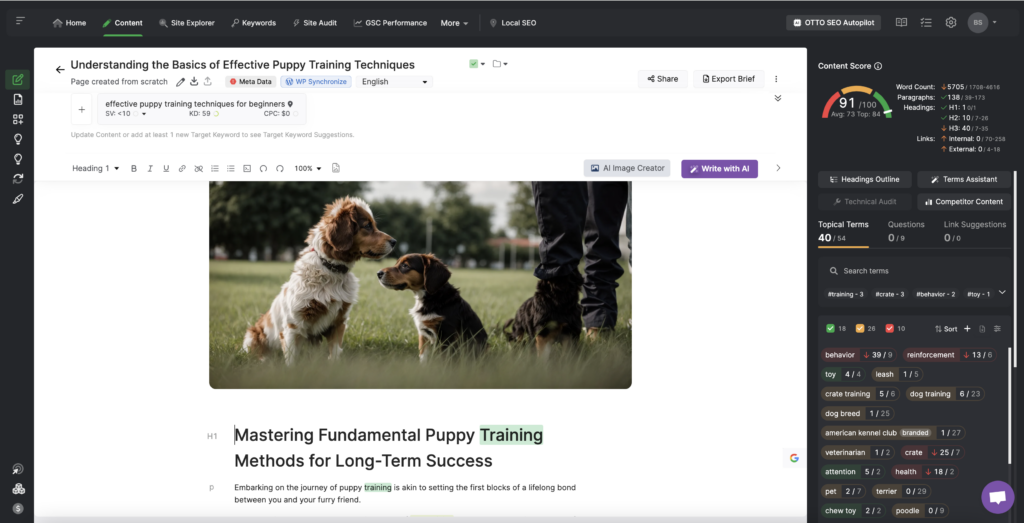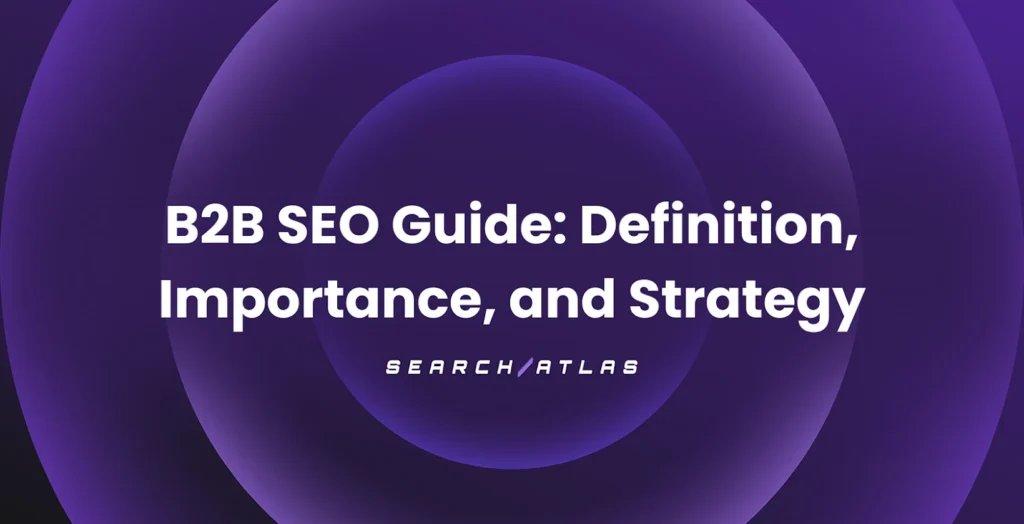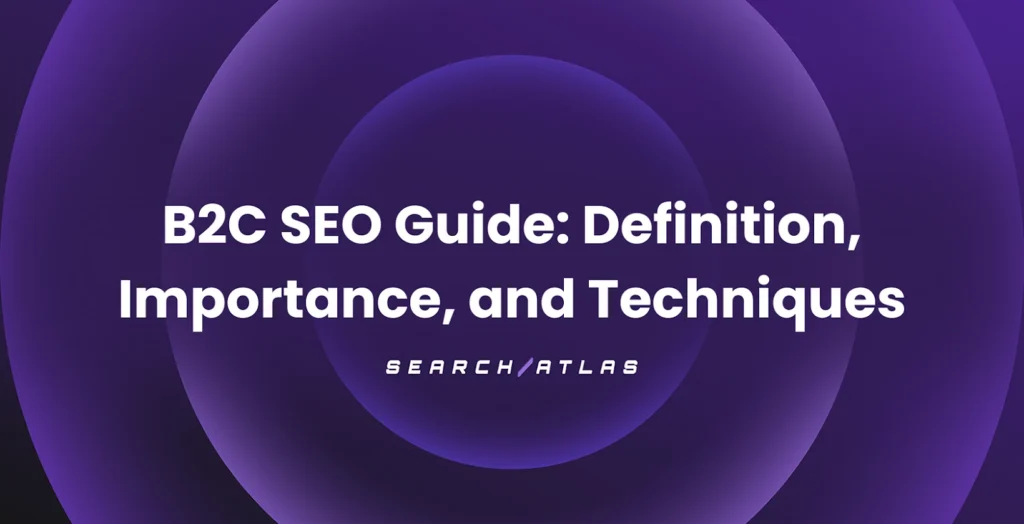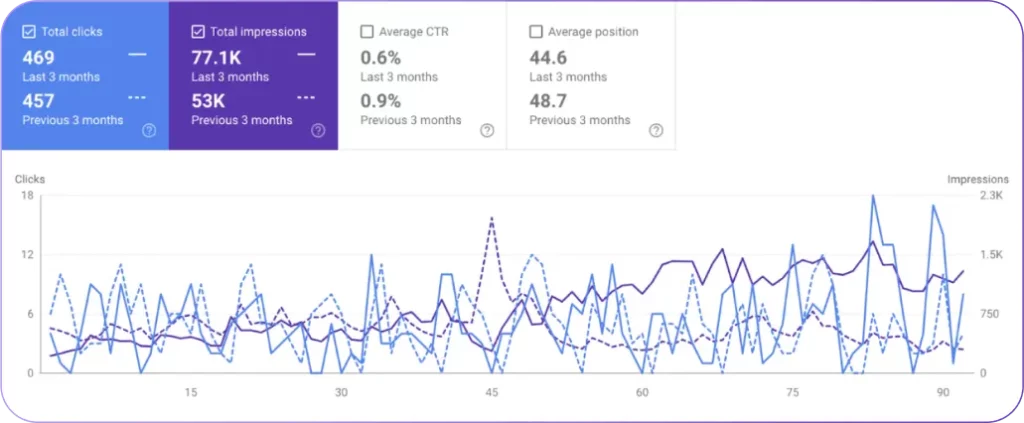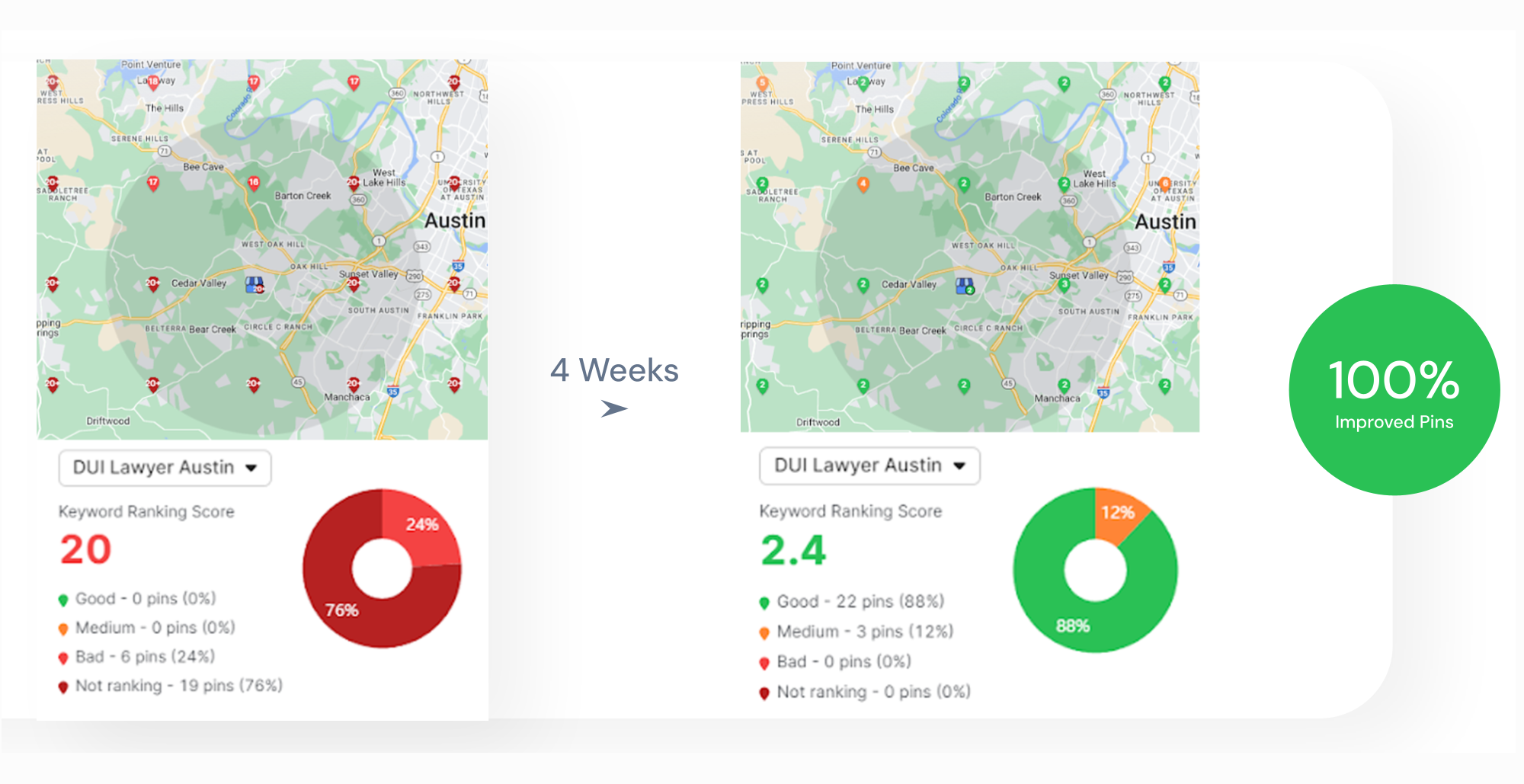Search engine optimization can feel overwhelming, especially when you’re just starting out.
With countless ranking factors, constant algorithm updates, and endless advice online, where do you even begin? 🤔
That’s why we created an SEO beginners guide to help. But also, we created AI SEO tools like OTTO SEO to make the benefits of optimization easy and accessible for everyone.
And here, instead of drowning in technical jargon, you’ll get a clear, step-by-step approach to making SEO work for you.
What is SEO?
SEO, or Search Engine Optimization, is the process of optimizing your website so it ranks higher in search engine results pages (SERPs), like Google results.
In simple terms, SEO helps search engines understand what your website is about and why it’s valuable to users. The goal? To drive organic traffic to your site by appearing at the top of search results when people look for information related to your business.
But how do you make that happen?
There are four key pillars of SEO that you need to focus on:
- On-Page SEO: Optimize meta tags (titles tags and meta descriptions), headings, and content to offer value and relevance for both users and search engines.
- Technical SEO: Improve site speed, mobile-friendliness, and crawlability by fixing errors, enhancing load times, and setting up sitemaps.
- Off-Page SEO: Boost site authority through quality backlinks, brand mentions, and social media engagement to increase trust and rankings.
- Content SEO: Create helpful, engaging content that aligns with search intent, providing value to users and improving your site’s visibility.
Focusing on these four pillars is the foundation of a solid SEO strategy. The next step is putting it all together to boost your visibility and attract the right audience!

10 Things Beginners Should Know About Making SEO Work
Here are 10 simple things every beginner should know to get started. Don’t worry, it really gets easier with time.
1. Understand SEO Basics to Boost Online Visibility
Understanding the basics of SEO is your first step toward boosting your online visibility and driving more traffic to your site. Without this foundation, it’s like setting out on a journey without a map. You might be doing a lot of work, but you won’t reach your destination as effectively or efficiently.
So why does it matter? Search engines are the gateway to most of your website’s traffic. If your site doesn’t follow SEO best practices, search engines won’t be able to understand or rank your content properly. That means fewer chances to show up in front of your potential audience.
Mastering SEO basics means understanding things like keywords, meta tags, and site structure. For example, if you use the right keywords in your content, title tags, and URLs, search engines can match your pages to the queries people are typing in.
And the more relevant your content is to those queries, the higher your chances of ranking.
SEO isn’t a quick fix, but by mastering the basics, you lay the groundwork to gradually increase your visibility, reach your audience, and achieve your business goals. 🎯
2. Find the Right Keywords to Attract Your Target Audience
Finding the right keywords is essential for attracting the right people to your website. Think of keywords as the bridge between your content and the search queries people are typing into Google.
If you’re not targeting the right terms, your potential customers might never find you. That’s where keyword research comes in!
Of course, you’ll need tools for this. ⛏️
We’ll use our tools as an example, because they really do make things easier.
The easiest way to get solid keywords for your website is to find the keyword most related to your business. For example, dog walking.
Then, you enter it into our Content Planner.
Then, the AI does everything else for you. It creates keyword lists you can use for each article (clustered around a certain topic), shows you how easy (or difficult) it is to rank for the keyword, and even offers to write it for you with AI.
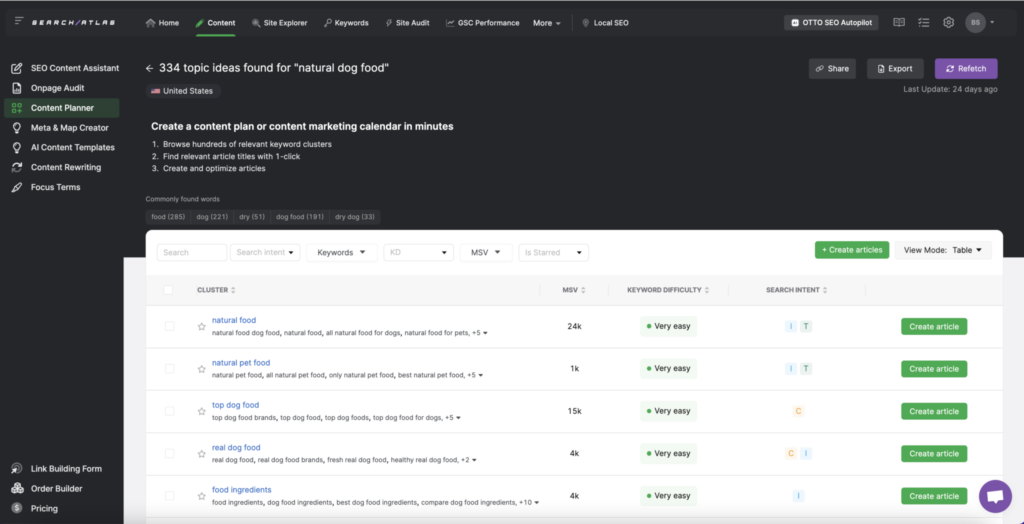
Well, that’s the easiest easiest way to do this, if you have no experience with SEO.
But once you get more comfortable with SEO or you want to see how it works, you can use keyword research tools for more control.
Once you do that, you should keep a few things in mind:
- Start with Long-Tail Keywords: Focus on specific phrases like “best running shoes for beginners” to reduce competition and rank more easily.
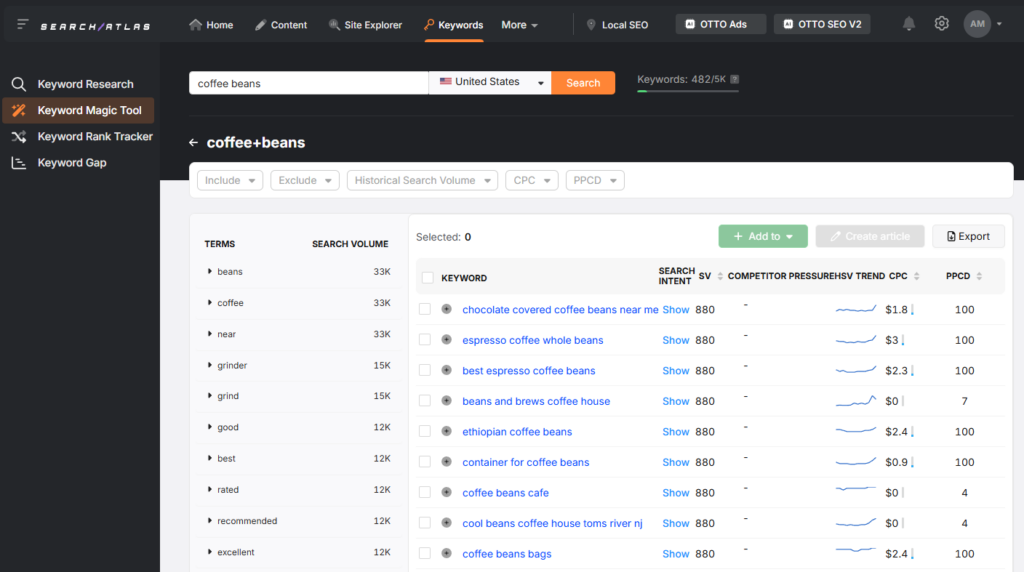
- Understand Search Intent: Know whether users are looking for information, making a purchase, or exploring options. Tailor your content to match these needs.
- Group Keywords by Topics: Organize keywords into related themes, such as “shoe brands” and “shoe features,” to improve content relevance.
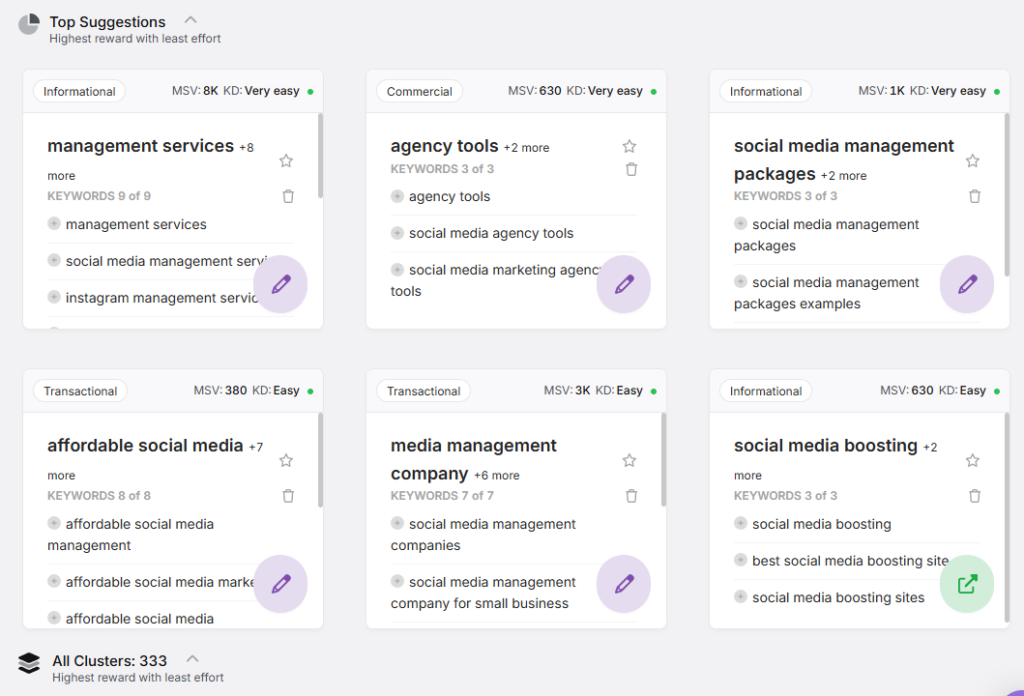
- Use Keyword Variations: Don’t just focus on one keyword. Use synonyms and related phrases to broaden your reach.

- Monitor and Update Regularly: SEO is ongoing. Keep track of keyword performance and update your strategy as trends change.
3. Optimize On-Page Elements to Improve Search Performance
On-page elements are key factors on your website that help search engines understand your content and rank it better. These elements are important for SEO because they directly influence your page’s visibility and SEO user experience (UX).
Here’s a breakdown of key on-page elements:
- Title Tags: The title of your page that appears in search results. It should include your target keyword and give users a clear idea of what the page is about.
- Meta Descriptions: The short snippet that appears under your title in search results. It should be compelling and include your main keyword to encourage clicks.
- Header Tags (H1, H2, etc.): These are the headings in your content that organize your page. The H1 is the main title of the page, and H2s or H3s break the content into sections. They help both users and search engines navigate your content easily.
- URL Structure: Your page’s web address. Make sure it’s short, descriptive, and includes your keyword (e.g., /best-running-shoes).
- Alt Text for Images: This is the text that describes an image. It helps search engines understand the image content and makes your site more accessible.
- Internal Links: Links within your site that connect to other pages. These help search engines crawl your site and keep users engaged by leading them to more valuable content.
- Content: The text, images, and videos on your page. It should be high-quality, relevant, and well-structured to answer users’ queries.
Optimizing them used to take more work, but if you’re starting with SEO in times of AI, you’re in luck. While you have more traditional on-page audit tools available, you also have tools that let you automatically find and fix many of these issues.
The way OTTO SEO does it.
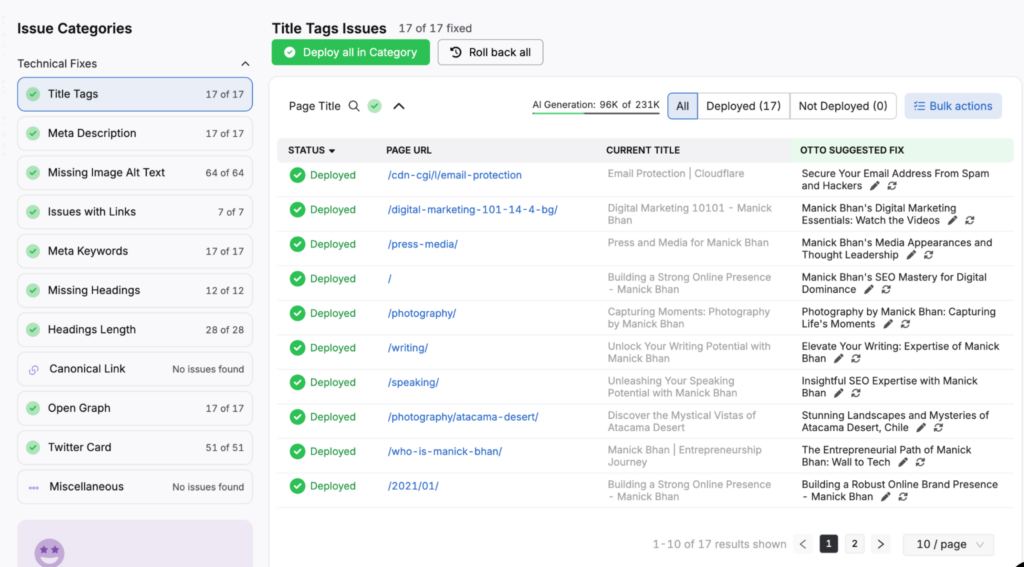
4. Create High-Quality Content to Rank and Engage Users
Quality content not only helps you connect with your audience but also signals to Google that your page is worth ranking. If your content answers users’ questions in a clear, helpful, and engaging way, search engines will reward you with better rankings.
You can write it yourself or with AI, but make sure to follow Google’s E-E-A-T guidelines. Essentially, create high quality, trustworthy content.
You can write everything yourself, which is great if you have the time and the energy. And we recommend it, especially for the most important pages on your website.
But you can also use AI to make this step easier.
Tools like Search Atlas AI Writer can help you generate relevant, high-quality content quickly and effectively. The AI Writer understands your target keywords and can produce well-structured text optimized for SEO, which means one less thing to worry about.
And if you want more control and to DIY this step, just use the SEO Content Assistant, an editor that will tell you what to optimize for in real time, as you write.
5. Fix Technical SEO Issues to Enhance Site Health
Technical SEO is the backbone of a well-optimized website. If you want to improve your rankings, it’s important to ensure your site is functioning properly behind the scenes.
But it’s pretty overwhelming once you’re just starting (it can even get annoying later) and you can use technical SEO tools to automate your efforts.
Here are the main technical SEO elements you should know about (or you know, keep them in mind for later):
- Site Speed: If your website takes too long to load, visitors might leave before they even see your content. Google also likes faster websites, so if yours is slow, it could hurt your rankings.
- Mobile-Friendliness: If your site doesn’t work well on mobile devices, users will leave quickly, and Google might rank you lower. It’s important to make sure your site is mobile-friendly, meaning it looks good and works properly on all screen sizes, from phones to tablets.
- URL Structure: A URL is the web address of your pages. A clean and simple URL helps both users and search engines understand what the page is about. For example, “/holiday-deals” is clearer than “/page?id=12345.” Keep URLs short, relevant, and easy to read.
- Site Architecture: Site architecture is how your website is organized. This means having clear menus, categories, and internal links to help visitors move around your site with ease.
- Duplicate Content: Duplicate content is when the same text appears on multiple pages of your site or even across different websites. Google doesn’t like this because it doesn’t know which page is the original, so it might ignore your content or lower its ranking.
- Broken Links: Broken links are links that don’t work anymore, leading visitors to an error page. If you find any, it’s important to either fix them or remove them so users and search engines don’t get stuck.
Okay, so that was a lot, but technical SEO is a whole branch of its own, and you might need a more detailed technical SEO guide to get you through.
We know it’s too much, and the worst part about doing this manually is that it takes forever. So, our AI assistant automates this too. And it fixes this with one click.
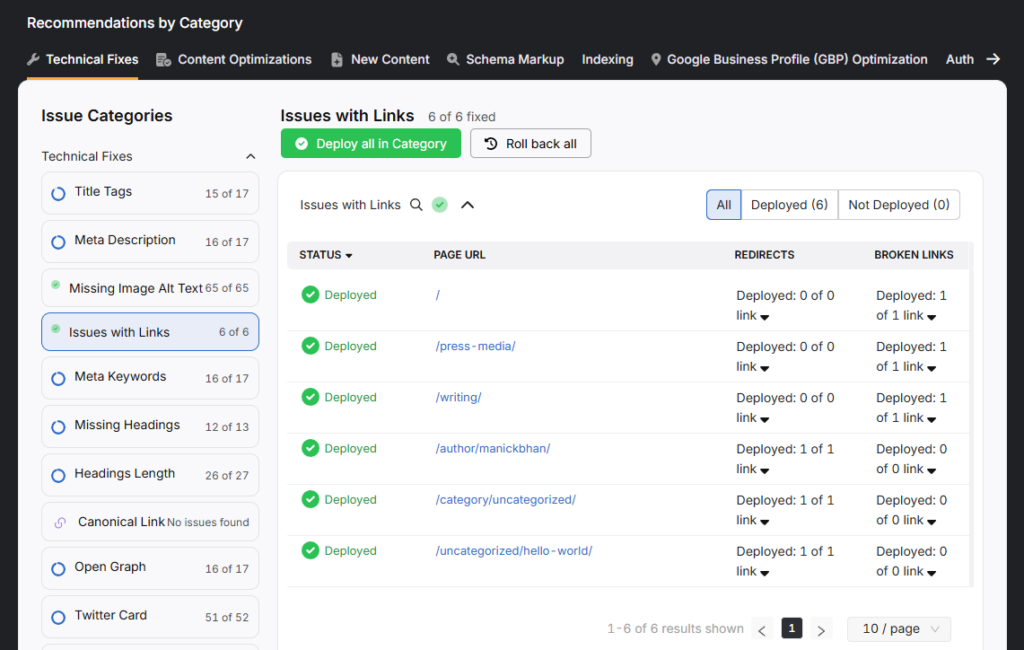
6. Build Backlinks to Increase Authority and Trust
Backlinks are simply links from other websites that point to your website. Think of them like “votes” or “recommendations” from other sites, telling Google that your content is valuable and worth checking out.
When a reputable website links to you, it’s like they’re saying, “Hey, this page is good!” The more of these votes (backlinks) you get from trusted sites, the more likely Google is to rank your pages higher in search results.
But how do you get these valuable links? Let’s break it down.
The first step in building backlinks is to understand where you stand. With Backlink Analyzer, you can check the current backlinks pointing to your website.
This tool will show you the quality, quantity, and diversity of your backlinks, giving you insights into what’s working and what needs improvement. You can use it to track competitors’ backlinks too, helping you find link-building opportunities that will drive traffic and boost your rankings.

After analyzing your backlinks, it’s time to focus on acquiring more. A Link Building Outreach Tool is your perfect companion here. It helps you reach out to relevant websites and bloggers in your niche for potential link-building opportunities.
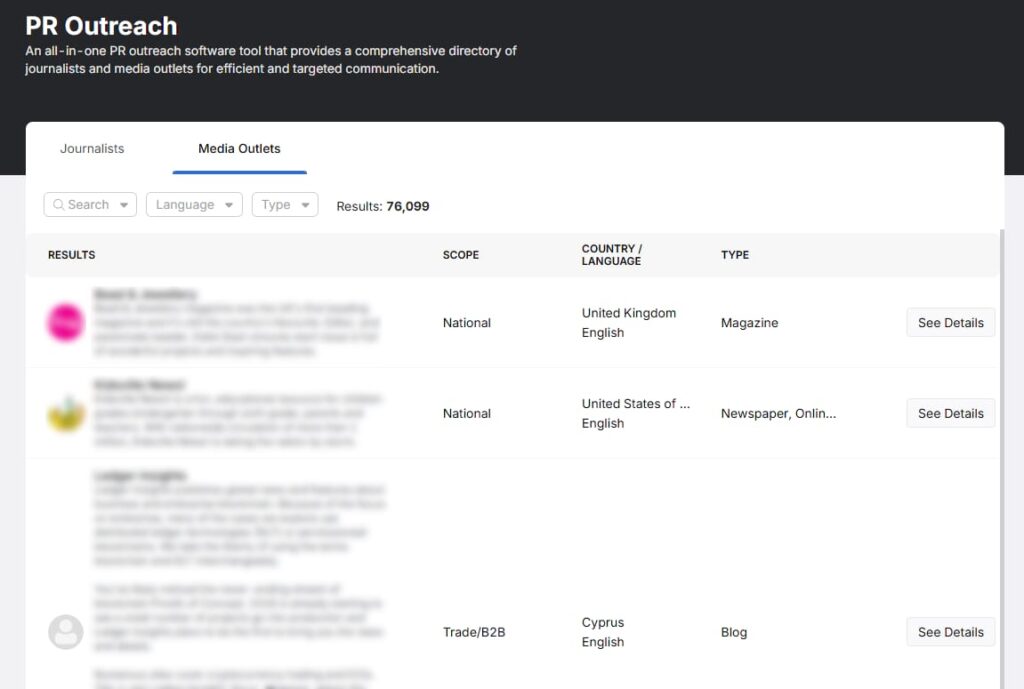
Also, create content that attracts links. Whether it’s in-depth articles, case studies, or unique data, the better your content, the more likely others are to link to it.
Offering something valuable—like an expert guide or a comprehensive resource—can make it easier to reach out to relevant websites and earn backlinks naturally.
And it’s really important to remember this next part. Not all backlinks are created equal.
A backlink from a high-authority, relevant site in your niche will carry more weight than one from a low-quality site. In fact, a shoddy backlink is like a really terrible person recommending you. It can hurt your reputation and rankings.
7. Use Local SEO to Get More Customers in Your Area
If you optimize your site for local search, you increase your chances of appearing in local searches, like “plumber near me” or “best pizza in [your city].” Let’s see how you can make it work for your business.
First, you have to ensure your business is listed correctly across local directories and websites. This includes places like Yelp, Yellow Pages, and local business directories.
We manage this too, with a Local Citation Builder tool. This tool makes it easy for you to build and manage these citations, ensuring your Name, Address, and Phone Number (NAP) are consistent across all platforms.

Next, optimize your Google Business Profile (GBP). That’s one of the best ways to get noticed in local searches. Search Atlas makes it easy to manage your GBP, update your hours, add new offers, and respond to customer reviews.
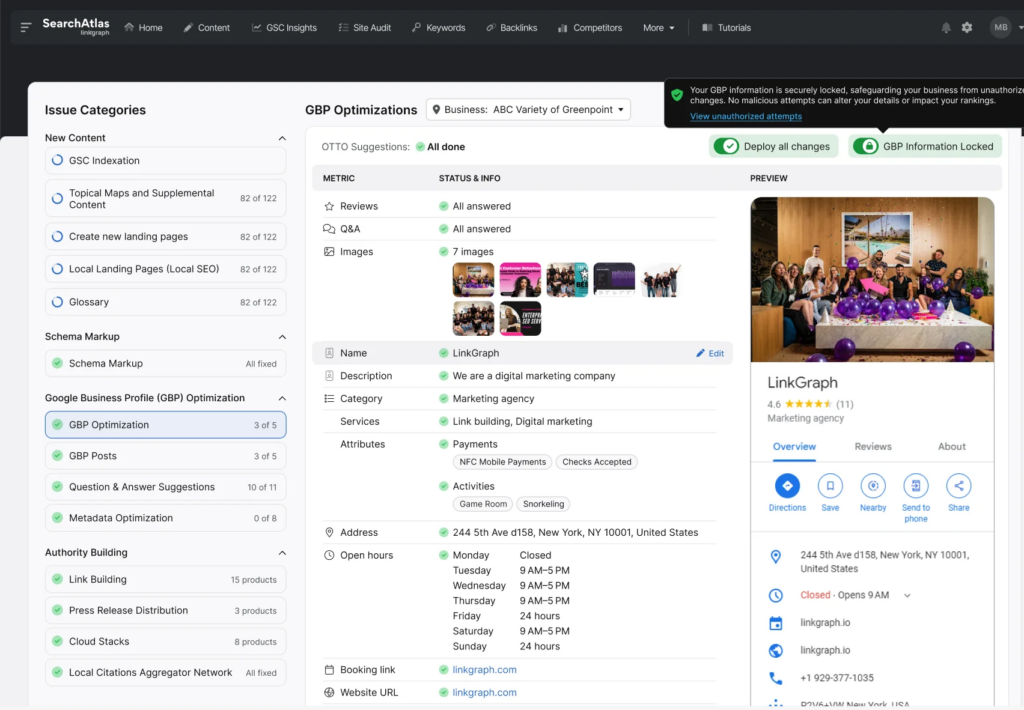
8. Track SEO Performance to Make Data-Driven Improvements
Without tracking, you’re essentially guessing what’s working and what’s not. It’s like driving a car without checking the speedometer—you won’t know if you’re speeding up, slowing down, or staying on course.
So, you need to use data and the right metrics.
And this is where the list gets a bit long, but there are a lot of them that matter 😅
- Organic Traffic: Shows how many visitors come to your site from search engines, helping you track if your SEO efforts are driving more traffic.
- Keyword Rankings: Helps you monitor where your target keywords rank in search results, indicating how effective your SEO strategy is.
- Click-Through Rate (CTR): Measures the percentage of people who click on your site after seeing it in search results, reflecting how well your title tags and meta descriptions are performing.
- Bounce Rate: Indicates how many visitors leave your site after viewing only one page, signaling whether your content or site is engaging enough.
- Backlinks: Shows the number and quality of external sites linking to yours, which impacts your site’s authority and rankings.
- Indexed Pages: Ensures Google is indexing all your important pages so they appear in search results.
- Conversion Rate: Measures how effectively your site turns visitors into customers or leads, showing the overall success of your SEO and user engagement.
- Top Landing Pages: Identifies which pages bring the most traffic, helping you see what’s working and replicate it across your site.
- Organic Impressions: Tracks how often your pages show up in search results, indicating if you’re ranking for more keywords, even if users aren’t clicking.
9. Avoid Common SEO Mistakes to Prevent Ranking Drops
When you’re just starting with SEO, it’s easy to make mistakes that can hurt your site’s rankings. People have done it before so you don’t have to.
Here’s what to watch out for (and yes, it’s a long list again):
- Keyword Stuffing: Overloading your content with too many keywords makes it less readable and could lead to penalties from Google. Instead, use keywords naturally and focus on delivering valuable content.
- Ignoring Mobile Users: More people are browsing on phones, so your site needs to be mobile-friendly. If it’s hard to navigate or slow to load on mobile, you’ll lose visitors and drop in rankings.
- Neglecting Site Speed: Slow websites frustrate users and can lower your rankings. Make sure your site loads quickly by optimizing images, using a good web host, and removing unnecessary plugins or scripts.
- Not Using Title Tags and Meta Descriptions: These are the first things people see in search results, so make sure they’re clear, relevant, and contain your target keywords. They help search engines understand your content and encourage clicks.
- Overlooking Internal Links: Internal links connect pages on your site, helping both users and search engines navigate. Without them, Google may struggle to index all your content properly, and users may miss important pages.
- Focusing Only on Backlinks: While backlinks are important, they’re not everything. If you’re too focused on building links and ignore things like content quality or user experience, your rankings could drop.
- Duplicate Content: If you have identical content on multiple pages of your site, Google might get confused about which page to rank.
10. Stay Updated on SEO Trends to Keep a Competitive Edge
SEO is not a one-and-done task; it’s a dynamic field that’s always changing. To stay ahead of your competitors and ensure your website keeps ranking well, you need to stay updated on the latest SEO trends and changes.
Here’s why this matters:
SEO isn’t an exact science. Google frequently updates its algorithms, and what worked yesterday might not work today.
For example, keyword density used to be super important. Now it really isn’t since Google is much smarter and it reads content with more understanding.
Changes like these show that SEO is always evolving. New tools, techniques, and best practices are continually introduced. By staying updated, you can make necessary adjustments before a small change becomes a big issue.
Follow SEO news, read industry blogs, and keep an eye on Google’s updates to ensure your site remains optimized and competitive.
Too much again?
No worries, OTTO SEO follows Google updates and other changes and adapts automatically 😉
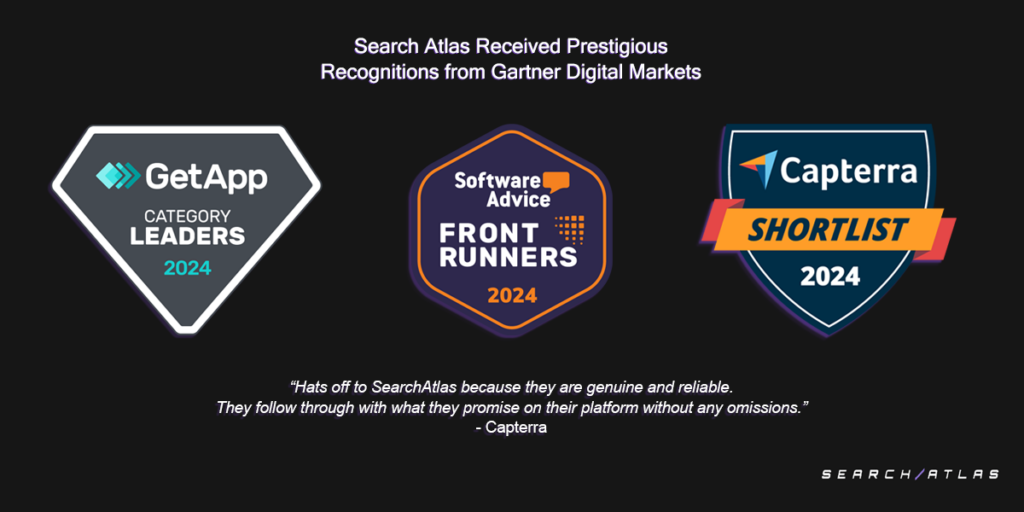
SEO Has Been Made Easy Thanks to Search Atlas AI Tools
SEO might sound overwhelming at first, but with the right tools, it becomes much easier to manage.
Search Atlas has taken the complexity out of SEO by offering AI-driven tools that help you optimize every part of your website, from content creation to technical tasks.
And with features like OTTO SEO, you’re equipped to drive more traffic and improve your rankings without the usual headaches.
Ready to see how easy SEO can be? Try Search Atlas today with a 7-day free trial and start optimizing your website for better results!


